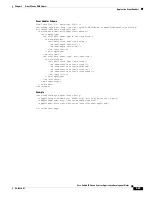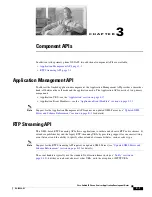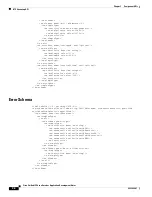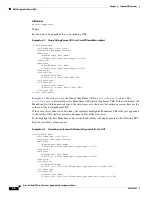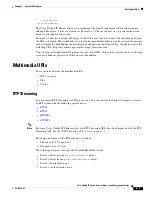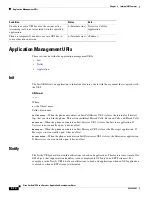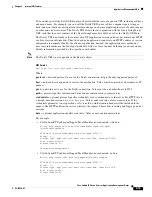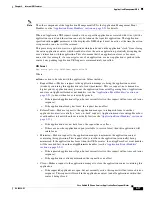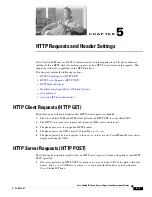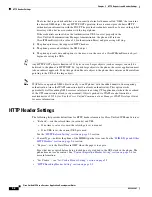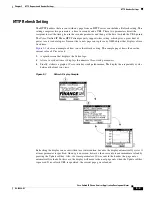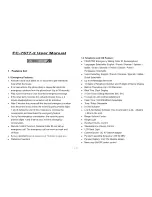
4-6
Cisco Unified IP Phone Services Application Development Notes
OL-18696-01
Chapter 4 Internal URI Features
XML Displayable Object URIs
URI Format
QueryStringParam:d
Where
d
= the data to be appended to a corresponding URL.
Example 4-1
QueryStringParam URI in a CiscoIPPhoneMenu object
<CiscoIPPhoneMenu>
<Title>Message List</Title>
<Prompt>Two Messages</Prompt>
<MenuItem>
<Name>Message One</Name>
<URL>QueryStringParam:message=1</URL>
</MenuItem>
<MenuItem>
<Name>Message Two</Name>
<URL>queryStringParam:message=2</URL>
</MenuItem>
<SoftKeyItem>
<Name>Read</Name>
<URL>http://server/read.asp</URL>
</SoftkeyItem>
<SoftKeyItem>
<Name>Delete</Name>
<URL>http://server/delete.asp</URL>
</SoftkeyItem>
</CiscoIPPhoneMenu>
Example 4-1
shows how to use the QueryStringParam URI in a
CiscoIPPhoneMenu
object. The
CiscoIPPhoneMenu
object includes two MenuItems with QueryStringParam URIs. If the user chooses the
MenuItem(s) with the numeric keypad, the cursor moves to that entry, but nothing executes because the
values are QueryStringParam URIs.
If the user presses either custom softkey, the currently highlighted MenuItem URI value gets appended
to the softkey URL that was pressed and requested from the web server.
If you highlight the first MenuItem and press the Read softkey, the phone generates the following URL:
http://server//read.asp?message=1
Example 4-2
Selecting an Item with Numeric Keypad Calls the URL
<CiscoIPPhoneMenu>
<Title>Message List</Title>
<Prompt>Two Messages</Prompt>
<MenuItem>
<Name>Messae One</Name>
<URL>http://server/messages.asp?message=1</URL>
</MenuItem>
<MenuItem>
<Name>Messae Two</Name>
<URL>http://server/messages.asp?message=2</URL>
</MenuItem>
<SoftKeyItem>
<Name>Read</Name>
<Position>1</Position><URL>QueryStringParam:action=read</URL>
</SoftKeyItem>
<SoftKeyItem>
<Name>Delete</Name>
<Position>2</Position><URL>QueryStringParam:action=delete</URL>


